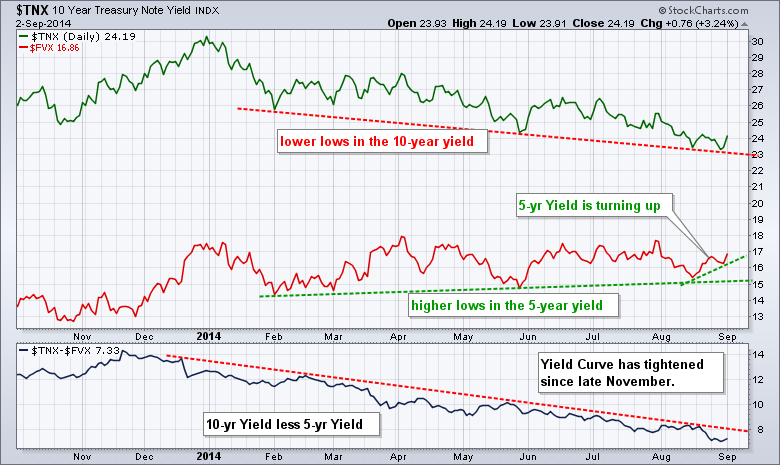It was a mixed day overall, but small-caps and regional banks showed some strength. DIA and SPY edged lower, while IWM and QQQ closely slightly higher. Five of the nine sectors were up with the Finance SPDR (XLF) leading the gainers. The Energy SPDR (XLE) got hammered as Spot Light Crude ($WTIC) fell over 2%. The Utilities SPDR (XLU) was down around 1% as the 10-YR Treasury Yield ($TNX) surged above 2.4%. Note that $TNX surged even as Oil plunged. This is possibly significant and should be watched going forward. The surge in long-term yields also helped the Regional Bank SPDR (KRE) to a modest gain. As the chart below shows, the 10-YR Yield formed lower lows this year, but the 5-YR Yield formed higher lows and turned up rather sharply the last two weeks. The yield curve (10-Yr less 5-Yr) remains in a downtrend though.
**This chart analysis is for educational purposes only, and should not
be construed as a recommendation to buy, sell or sell-short said securities**
**************************************************************
No change. SPY surged over 5% and then consolidated around the 200 level last week. Even though the ETF seems overbought, this is a consolidation within an uptrend and it is bullish. What little selling pressure we saw mid week was answered with another bout of buying pressure. Notice how SPY dipped below 200 and then moved right back above. I am marking key support in the 198.5-199 area.

**************************************************************
No change. QQQ extended its uptrend and hit another new high on Friday. After surging above 99.5 to start the week, the ETF consolidated with a falling flag of sorts. QQQ broke above the flag trend line on Friday and I am raising key support to the 98.5-99 area. The Raff Regression Channel and mid August consolidation combine to mark support here.

**************************************************************
No change. IWM may be underperforming SPY, but it is in an uptrend since early August and by no means weak. This uptrend is steady with a rising channel taking shape the last four weeks. The lower trend line and late August low mark key support in the 113.8-115 area. The price relative (IWM:SPY ratio) continues to edge lower. Watch for a breakout to signal relative strength in small-caps.

**************************************************************
The 20+ YR T-Bond ETF (TLT) hit a new high near 119 last week and promptly fell below 117 on Monday. This decline is certainly sharp and worth noting, but not quite enough to reverse the two month uptrend. Key support remains in the 115.5 area, and a break below this zone would reverse the short-term uptrend. The indicator window shows the 5-year Treasury Yield ($FVX) challenging its August highs.

**************************************************************
No change. The US Dollar ETF (UUP) broke out near 21.8 in August and moved to a new high for the move last week. Similarly, the Euro Index ($XEU) moved to a new low and remains in a strong downtrend. No change here. UUP support is set at 21.65 and XEU resistance at 134.50. The Yen is also weakening versus the Dollar.

**************************************************************
The USO Oil Fund (USO) broke descending triangle support to signal a continuation of the bigger downtrend. Broken support then turned into resistance in the 36 area as the ETF reversed course on Monday. With a reaction high, I will mark key resistance at 36.

**************************************************************
The Gold SPDR (GLD) broke flag support with a big move down. The only positive here is that gold is short-term oversold and near the lower trend line of a falling channel. The upper trend line and a buffer mark key resistance in the 125.5-126 area. A strong Dollar remains a drag on gold and geopolitics are not factoring into the equation.

***************************************************************
Key Reports and Events (all times Eastern):
Tue - Sep 02 - 10:00 - ISM Manufacturing Index (59: very strong)
Tue - Sep 02 - 10:00 - Construction Spending (up 1.8%: very strong)
Wed - Sep 03 - 07:00 - MBA Mortgage Index
Wed - Sep 03 - 10:00 - Factory Orders
Wed - Sep 03 - 14:00 - Fed's Beige Book
Wed - Sep 03 - 14:00 - Auto Sales/Truck Sales
Thu - Sep 04 - 07:30 - Challenger Job Report
Thu - Sep 04 - 08:15 - ADP Employment Report
Thu - Sep 04 - 08:30 - Initial Jobless Claims
Thu - Sep 04 - 10:00 - ISM Services Index
Thu - Sep 04 - 10:30 - Nat Gas Inventories
Thu - Sep 04 - 11:00 - Crude Oil Inventories
Fri - Sep 05 - 08:30 - Employment Report
Chart Setups on Tuesday and Thursday.
This commentary and charts-of-interest are designed to stimulate thinking. This analysis is not a recommendation to buy, sell, hold or sell short any security (stock ETF or otherwise). We all need to think for ourselves when it comes to trading our own accounts. First, it is the only way to really learn. Second, we are the only ones responsible for our decisions. Think of these charts as food for further analysis. Before making a trade, it is important to have a plan. Plan the trade and trade the plan. Among other things, this includes setting a trigger level, a target area and a stop-loss level. It is also important to plan for three possible price movements: advance, decline or sideways. Have a plan for all three scenarios BEFORE making the trade. Consider possible holding times. And finally, look at overall market conditions and sector/industry performance.

